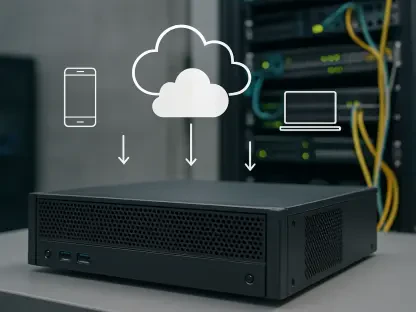The rapid adoption of hybrid cloud AI is transforming the way enterprises operate, seamlessly integrating on-premises data centers with public cloud environments to tap into diverse AI models and immense computational power. As businesses shift from exploratory AI experiments to practical, results-oriented implementations, they encounter a complex set of challenges that extend far beyond mere technical integration. This convergence of platforms fuels innovation by enabling scalability and flexibility, yet it simultaneously exposes organizations to heightened security risks that can undermine these advancements. The intricate architecture of hybrid cloud AI, while a catalyst for progress, creates an expanded attack surface that traditional defenses are often ill-prepared to handle. This article delves into the pivotal role of security as the bedrock of successful hybrid cloud AI adoption, examining the evolving threat landscape, the necessary shifts in security approaches, and the strategic measures required to safeguard these powerful systems.
Navigating the New Risks of Hybrid Cloud AI
The inherent design of hybrid cloud AI, which connects disparate systems across multiple environments, significantly broadens the potential points of vulnerability for enterprises. Unlike traditional IT setups, where threats were often predictable and confined to specific entry points, this integrated approach introduces a dynamic attack surface that is far more challenging to secure. AI-specific dangers, such as prompt injections and adversarial attacks—often orchestrated by rival AI systems—add a layer of complexity to the risk profile. These threats exploit the very mechanisms that make AI powerful, turning innovation into a potential liability. To counter this, a robust, end-to-end security framework is essential, one that vigilantly monitors and protects interactions across countless endpoints. Without such measures, the promise of scalability and agility in hybrid cloud AI could be overshadowed by devastating breaches that compromise sensitive data and erode trust in these technologies.
Beyond the technical intricacies, the evolving nature of cyber threats targeting hybrid cloud AI demands a proactive rather than reactive stance from organizations. The sophistication of attacks, where malicious actors leverage AI to craft highly targeted exploits, underscores the inadequacy of legacy security protocols in this new era. Consider the implications of a breach in a system handling vast datasets across distributed platforms—such an incident could disrupt operations on a massive scale. Enterprises must therefore prioritize the development of adaptive security strategies that evolve alongside these threats, ensuring continuous protection of critical assets. This involves not only deploying advanced tools but also fostering a culture of security awareness that permeates every level of the organization. Only by anticipating and preparing for these unique risks can businesses fully harness the transformative potential of hybrid cloud AI without falling victim to its inherent vulnerabilities.
Adapting Security to the Core of AI Interactions
As hybrid cloud AI redefines the enterprise IT landscape, the traditional focus on network-layer security is giving way to a more nuanced emphasis on application-specific layers, particularly layer seven, where critical AI interactions occur. This is the domain of API calls, tokens, and prompts—elements central to AI functionality but also prime targets for exploitation. The importance of securing internal communications, often referred to as east-west traffic, now rivals that of external-to-internal exchanges, highlighting a fundamental shift in how security must be conceptualized. With attackers increasingly focusing on these AI-driven interactions, organizations are compelled to adopt cutting-edge tools and methodologies tailored to this environment. This transition is not merely a technical adjustment but a strategic imperative to protect the core mechanisms driving AI innovation across hybrid cloud architectures.
Moreover, the shift to application-layer security brings with it a need for specialized expertise and solutions that can address the unique challenges posed by AI traffic. Unlike conventional data flows, AI interactions often involve complex, real-time exchanges that require both precision and speed in security enforcement. Failure to secure these interactions can expose enterprises to novel attack vectors, such as those exploiting API vulnerabilities or manipulating model inputs. To mitigate these risks, businesses must invest in technologies that provide granular visibility and control over application-layer activities, ensuring that threats are detected and neutralized before they escalate. This approach not only safeguards critical operations but also reinforces the integrity of AI systems, enabling enterprises to scale their deployments with confidence. Adapting to this new security paradigm is essential for maintaining a competitive edge in a landscape increasingly defined by hybrid cloud AI.
Striking a Balance Between Protection and Efficiency
Security in the realm of hybrid cloud AI extends beyond mere defense mechanisms; it must coexist with the imperative for high performance, a non-negotiable factor in enterprise operations. Encryption and stringent policy enforcement, while indispensable for protecting data as it moves across distributed systems, often introduce latency that can hinder the efficiency of large language models (LLMs) and other AI tools. This performance drag poses a significant obstacle for organizations aiming to scale their AI initiatives without compromising on speed or responsiveness. Solutions such as smart load balancing and advanced API security measures offer a way to reconcile these competing demands, providing robust protection without sacrificing operational agility. Navigating this balance is a central challenge, one that shapes the trajectory of hybrid cloud AI adoption in competitive business environments.
Equally important is the recognition that performance issues, if left unaddressed, can erode the very benefits that hybrid cloud AI promises to deliver. Latency in AI operations not only affects user experience but can also impact decision-making processes that rely on real-time insights. Enterprises must therefore prioritize the integration of security solutions that are optimized for minimal impact on system performance, ensuring that protective measures enhance rather than impede functionality. This requires a careful evaluation of tools and strategies, from dynamic traffic management to lightweight encryption protocols, that can support the dual goals of safety and efficiency. By achieving this equilibrium, organizations can fully leverage the power of hybrid cloud AI, driving innovation while maintaining the trust of stakeholders. The path forward lies in continuous refinement of these approaches to meet the evolving demands of both technology and business.
Harnessing Collaboration for Robust AI Security
The multifaceted security challenges of hybrid cloud AI cannot be tackled through isolated efforts; they necessitate strategic collaboration and partnerships that span across industry players. Alliances, such as those forged between Google Cloud and technology leaders like F5 and NetApp, exemplify the move toward unified, cross-cloud security frameworks that address the fragmented nature of hybrid environments. These partnerships focus on securing AI traffic and critical interactions across diverse platforms, ensuring that protection is seamless regardless of where data or models reside. By overcoming the limitations of siloed security approaches, such collaborative efforts create a fortified ecosystem that is better equipped to handle the complexities of modern AI deployments. This collective strength is indispensable for sustaining trust and reliability in hybrid cloud AI systems.
Furthermore, collaboration extends beyond mere technical integration to encompass shared knowledge and innovation in security practices. The exchange of insights and best practices among industry partners fosters the development of adaptive solutions that can keep pace with emerging threats in the AI landscape. This cooperative approach also enables standardization of security protocols across platforms, reducing vulnerabilities that arise from inconsistent implementations. Enterprises benefit from access to a broader pool of expertise and resources, which can be pivotal in preempting and mitigating risks unique to hybrid cloud AI. As these partnerships continue to evolve, they set a precedent for how the industry can collectively address the intricate security needs of AI, ensuring that innovation is not stifled by the fear of breaches. The future of secure hybrid cloud AI hinges on such unified endeavors to build resilient, integrated defenses.
Reflecting on Security as the Foundation of AI Progress
Looking back, the journey of hybrid cloud AI revealed a landscape where security stood as the linchpin of sustainable innovation. Enterprises grappled with an expanding array of threats, from AI-driven attacks to performance bottlenecks, yet found pathways through adaptive strategies and collaborative efforts. The shift to application-layer security marked a turning point, addressing the unique nature of AI interactions, while partnerships between tech giants paved the way for unified protection across fragmented systems. As organizations navigated these challenges, the elevation of security to a strategic priority became evident, shaping boardroom discussions and resource allocations. Moving forward, the focus should center on continuous investment in cutting-edge tools and cross-industry alliances to anticipate future risks. Prioritizing scalable, performance-friendly security solutions will be key to unlocking the full potential of hybrid cloud AI, ensuring that innovation thrives in a safeguarded environment.









